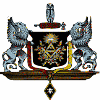Why Saints John?
Postado Quinta-feira, 17 Setembro, 2009 as 11:49 AM pelo Ir:. HUELEN LODGE A.F. & A.M.Santiago, Chile
![]() There have been several stories and theories relating to the connection
between Saint John the Baptist, Saint John the Evangelist and the
Masonic Fraternity. There is no question that the two are patron saints
of Masonry, but some of the stories concerning them are open to
discussion just as those claiming that Noah, Moses and King Solomon were
Freemasons and those claiming that the first Masonic lodge was located
in Jerusalem.
There have been several stories and theories relating to the connection
between Saint John the Baptist, Saint John the Evangelist and the
Masonic Fraternity. There is no question that the two are patron saints
of Masonry, but some of the stories concerning them are open to
discussion just as those claiming that Noah, Moses and King Solomon were
Freemasons and those claiming that the first Masonic lodge was located
in Jerusalem.
In 1737, the Grand Orator of the Grand Lodge of France, Chevalier Ramsey, made a speech ascribing the origin of Freemasonry to an order of crusading knights who had fought so valiantly for possession of the Holy Land, saying that, "Some times after, this order was united with that of the Knights of Saint John of Jerusalem, for which reason in all countries our lodges are called lodges of Saint John." Many Masons believe Ramsey’s statement, but the evidences are not yet conclusive.
What is felt to be closest to the truth is the following. Centuries ago, the early Christian churches adopted the old pagan customs of celebrating the summer and winter solstices, which happened to be traditional festival dates for several ancient deities. These celebrations were dedicated to Saint John the Baptist and Saint John the Evangelist and took place on June 24 and December 27, respectively. In later years, as building guilds and other associations were formed, the civil and religious authorities required each chartered body to name one or more patron saints and to observe that saint's day as a holiday. By the sixteenth century, the Masonic guilds, like the churches, were associating themselves with both Saints John. This probably explains where the idea got started that both had been members of the fraternity. Neither of them was a Freemason of course.
The bottom line is this. The two saints are eminent patrons of Masonry because many Grand Lodges have preserved and continued the ancient customs of observing the summer and winter solstices and the naming of patron saints.
Let’s go a little further and analyze why it is appropriate that the two Saints John can be considered the traditional patrons of Masonry.
By the way, John means "Jehovah has been gracious" in Hebrew.
John the Baptist. After spending time in the desert in prayer and meditation, John the Baptist began a ministry which preached reformation. Reformers today generally speak of reforming institutions or society. John the Baptist preached reformation of the individual, thereby reforming society one person at a time. As a sign of new life, initiates of this philosophy were given a ritual bath or baptism. John the Baptist preceded and baptized Jesus. In the middle of a desert, purification by cooling water must have held a special significance. This ceremony, combined with a commitment to change one's life, had to be personally and spiritually uplifting.
John the Evangelist. We know John the Evangelist from his writings, one Gospel and three letters. His message is that to know and love God is to obey His law, that the essential mark of grace is brotherly love, and that the ideal life is to live in a community or fellowship with others of like mind and spirit. In short, God is love, and he who dwells in love, dwells in God, and God in him.
The assignment of the feast of St. John the Evangelist on the winter solstice is also symbolically interesting since that day has the least amount of sunlight, but is followed by increasingly longer days of light. The date represents a rebirth, seasonal and personal, following long darkness. Since the goal of Freemasonry is to make good men better, its two great patrons are, appropriately, the Holy Saints John.
As a conclusion, we have an indisputable historic connection between the two saints and freemasonry. But, maybe much more important is the symbolism that each of their lives carries and that definitely connects them with freemasonry.
Jorge Cifuentes
Santiago, March 2001
Categoria Public.Int (RSS)


